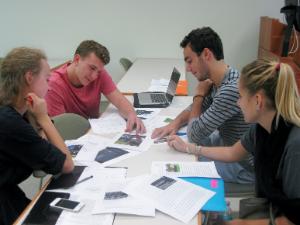Like living in a Residential College or enjoying a Friday afternoon at “the Rat,” English Composition classes are part of every first-year student’s experience at the University of Miami.
As the UM student body diversifies – drawing more international students than ever before, and opening the doors of higher education to an ever-growing number of young people – the talented team of lecturers in the English Composition Program offered through the UM College of Arts & Sciences is using technology and team-teaching methods to enhance its student-centered approach.
 |
| Students in Judy Hood’s English 105 class share their inquiry writing projects in a peer review group. |
“We have a wide range of students, and we work to meet the needs of students coming from all over the world,” says Judy Hood, a senior English composition lecturer in the College of Arts & Sciences, who teaches required courses English 105 and 106.
More than 15% of the student body comes from outside the United States, and the professors work hard to make their classes culturally inclusive – and select topics that will “grab them and keep them engaged,” Hood says.
This includes finding topics and teaching methods that are effective for cohorts of diverse students with different goals and communication skills, ranging from engineering students to student-athletes, math and science majors, and strong writers who enter UM with writing credits they earned through the Advanced Placement writing examinations.
The goal is to teach all students to write effectively for college and beyond, to ask meaningful questions and seek answers in texts, society and themselves. This allows them to grow as writers, developing the critical thinking and data analysis skills that are essential to all disciplines.
“We do not change the curriculum for a specific group of students but look for ways critical thinking and communication skills will contribute to every student’s success,” Hood says.
“We aim to bring their writing skills in line with their critical thinking skills,” adding that every class “starts with a conversation” and that all students have the opportunity to tailor their final projects to their interests and needs.
Composition students share their work in various settings: with their full classes (no more than 19 students per section), in four-to-five student peer review groups, and one-on-one with their peers and their professors.
“Our students are remarkably generous and interested in helping one another,” she said. “They are also open to listening to what their peers say and building on it to improve their work.”
The Composition lecturers participate in “Teaching Circles,” which bring four or five teachers together to investigate a pedagogical topic. During the last school year, the focus for most of the circles was collaborating with multi-media in the Composition curriculum.
Hood says, “We want to offer our students as many opportunities as possible to integrate technology into their writing process.”
Hood also participated in the Office of the Provost’s Faculty Learning Community on technology, which brought together faculty from across UM to investigate ways to enhance teaching and learning through incorporating information and communication technology.
She says that digital tools have given students more opportunities to review and comment on each other’s work, and allowed students who are not comfortable speaking up in class to more fully participate and develop confidence. Websites, blogs, and Blackboard discussion forums encourage interaction among students. These resources also help students “ease into the idea of publishing what they write,” she says.
“People think that technology takes over,” Hood says, “but it actually helps students break down units and see how things connect.” She likened the pieces of a written work to building blocks, and said that technology can help students see how to “build the blocks into a tower.”
Hood’s courses focus on visual rhetoric, exploring the relationship between images and words and its effectiveness for engaging an audience and provoking critical thinking. She helps students explore and express their observations and analysis through the collaboration of visual and verbal texts. Last semester, she worked with the campus Media Lab to help students create their own books.
Her students responded particularly enthusiastically to One Water, a 22-minute-long, non-verbal filmproduced by an interdisciplinary team of UM faculty, which brings attention to the global water crisis. Hood showed the powerful documentary to her students, who then designed their final researched projects prompted by these images.
The students produced essays, poetry, stories, books and videos. Hood says, “The students learned how to present information in an organized way, but also how to present it in a way that is viable for today’s environment.”
She adds that they learned the power of context, and “lensing” – recognizing the role of the viewer/reader’s interpretation of a visual or written piece. Finally, she says, “They learned that they don’t have to come to a conclusion, don’t have to prove something. They need to ask the questions that will open the conversation instead of shutting it down.”
June 17, 2014

